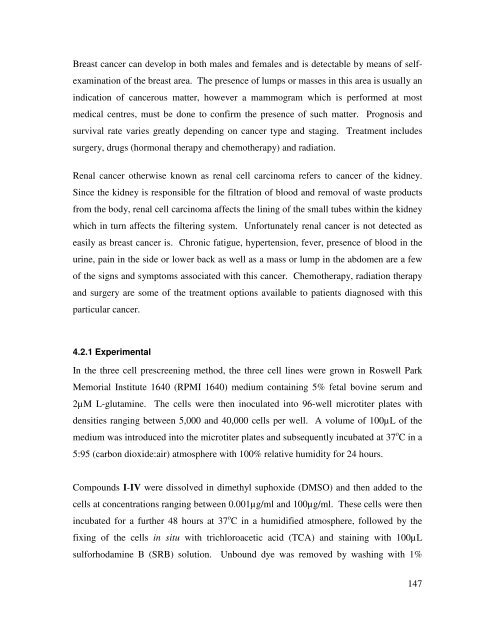university of kwazulu-natal faculty of science and agriculture school ...
university of kwazulu-natal faculty of science and agriculture school ...
university of kwazulu-natal faculty of science and agriculture school ...
Create successful ePaper yourself
Turn your PDF publications into a flip-book with our unique Google optimized e-Paper software.
Breast cancer can develop in both males <strong>and</strong> females <strong>and</strong> is detectable by means <strong>of</strong> self-<br />
examination <strong>of</strong> the breast area. The presence <strong>of</strong> lumps or masses in this area is usually an<br />
indication <strong>of</strong> cancerous matter, however a mammogram which is performed at most<br />
medical centres, must be done to confirm the presence <strong>of</strong> such matter. Prognosis <strong>and</strong><br />
survival rate varies greatly depending on cancer type <strong>and</strong> staging. Treatment includes<br />
surgery, drugs (hormonal therapy <strong>and</strong> chemotherapy) <strong>and</strong> radiation.<br />
Renal cancer otherwise known as renal cell carcinoma refers to cancer <strong>of</strong> the kidney.<br />
Since the kidney is responsible for the filtration <strong>of</strong> blood <strong>and</strong> removal <strong>of</strong> waste products<br />
from the body, renal cell carcinoma affects the lining <strong>of</strong> the small tubes within the kidney<br />
which in turn affects the filtering system. Unfortunately renal cancer is not detected as<br />
easily as breast cancer is. Chronic fatigue, hypertension, fever, presence <strong>of</strong> blood in the<br />
urine, pain in the side or lower back as well as a mass or lump in the abdomen are a few<br />
<strong>of</strong> the signs <strong>and</strong> symptoms associated with this cancer. Chemotherapy, radiation therapy<br />
<strong>and</strong> surgery are some <strong>of</strong> the treatment options available to patients diagnosed with this<br />
particular cancer.<br />
4.2.1 Experimental<br />
In the three cell prescreening method, the three cell lines were grown in Roswell Park<br />
Memorial Institute 1640 (RPMI 1640) medium containing 5% fetal bovine serum <strong>and</strong><br />
2µM L-glutamine. The cells were then inoculated into 96-well microtiter plates with<br />
densities ranging between 5,000 <strong>and</strong> 40,000 cells per well. A volume <strong>of</strong> 100µL <strong>of</strong> the<br />
medium was introduced into the microtiter plates <strong>and</strong> subsequently incubated at 37 o C in a<br />
5:95 (carbon dioxide:air) atmosphere with 100% relative humidity for 24 hours.<br />
Compounds I-IV were dissolved in dimethyl suphoxide (DMSO) <strong>and</strong> then added to the<br />
cells at concentrations ranging between 0.001µg/ml <strong>and</strong> 100µg/ml. These cells were then<br />
incubated for a further 48 hours at 37 o C in a humidified atmosphere, followed by the<br />
fixing <strong>of</strong> the cells in situ with trichloroacetic acid (TCA) <strong>and</strong> staining with 100µL<br />
sulforhodamine B (SRB) solution. Unbound dye was removed by washing with 1%<br />
147

















